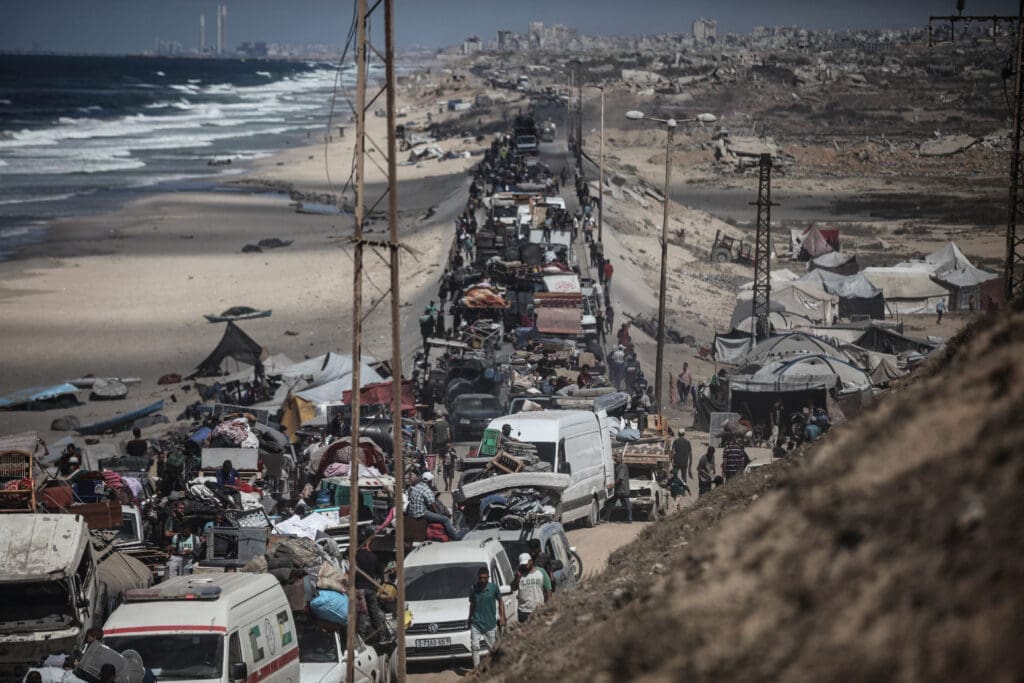U.S. President Donald Trump’s 20-point proposal for a ceasefire in Gaza, announced alongside Israeli Prime Minister Benjamin Netanyahu at the White House, is far from a clear and credible blueprint for ending the onslaught on the besieged Palestinian territory. Vague and devoid of timetables, it reads less like a peace plan and more like the terms of surrender. Yet for the Palestinians, accepting it may be the least bad option.
With the exception of a 72-hour deadline for releasing hostages, nearly all the plan’s 20 points are left open to subsequent negotiations and endless delays. The Palestinians’ disastrous experience with the Oslo Accords has given them many reasons to be deeply skeptical of any process framed around open-ended talks between vastly unequal parties. This is especially true when one of those parties is Netanyahu’s far-right government, which has already violated multiple ceasefires in Gaza and Lebanon since hostilities began on October 7, 2023.
Yet for all the plan’s flaws, Hamas faces an agonizing truth. Rejecting it outright risks condemning Gaza to oblivion. After two years of unchecked genocide, it is clear that no one is coming to save the people of Gaza. Hamas certainly cannot protect them—but it can doom them. With no viable alternative on the horizon, even a deeply compromised ceasefire may be the only way to stop the daily slaughter and starvation of Gaza. Palestinians can fight for their long-term goals later. The immediate priority must be survival.
Echoes of the Past
The Trump plan’s ambiguities are not accidents. They create space for Israel to delay indefinitely, to condition implementation on ever-shifting security demands, and to claim it is complying, while avoiding meaningful concessions.
Palestinians are no strangers to this dynamic. The Oslo Accords of the early 1990s were premised on phased Israeli withdrawals from the occupied Palestinian territories, to be replaced by the Palestinian Authority (PA). Decades later, Israel’s occupation is further entrenched, fragmenting the West Bank into Palestinian Bantustans surrounded by ever-expanding Israeli settlements.
The echoes in the Trump plan are unmistakable.
At the heart of the proposal is a gradual Israeli withdrawal from Gaza and the deployment of an international force. Yet the language is slippery: withdrawal may not be total, and benchmarks are undefined. The plan also demands the demilitarization of Gaza and the disarmament of Hamas, despite Israel’s continuing occupation of the strip. For many Palestinians, surrendering arms under such conditions feels more like capitulation than peace.
The proposal stipulates a role for the PA, albeit heavily circumscribed and delayed to an indefinite point in the future. Israel has resisted the body’s return to Gaza since October 7, fearing the unification of Gaza and the West Bank under a single governance structure. Instead, Gaza is to be administered by a committee of technocrats unaffiliated with political factions, overseen by a so-called Board of Peace.
This body will be chaired by Trump himself and managed by former British Prime Minister Tony Blair—two figures whose track records inspire little confidence, to say the least. Trump will not dedicate serious time or political capital to supervising such an experiment; Blair’s previous interventions in Middle East peace efforts, quite aside from his central role in the disastrous 2003 invasion of Iraq, achieved little beyond photo opportunities. The likely outcome is a leadership vacuum, one that Israel can exploit to shape events unilaterally.
Still, the plan is a massive departure from the idea Trump floated in February, calling for the permanent displacement of Palestinians and the development of a “Gaza Riviera.” The Israeli government has run with that notion ever since, referring to it as their guiding vision for the territory’s future. Accordingly, several aspects of the current deal run counter to Netanyahu’s objectives.
One of the clearest points in the latest plan is that “no one will be forced to leave Gaza, and those who wish to leave will be free to do so and free to return.” In principle, this prohibits the ethnic cleansing of Gaza that Israel has been pursuing since October 2023.
The plan also calls for an immediate influx of humanitarian aid and the repairing of critical infrastructure. Principles like the prohibition on Israeli annexation and occupation of Gaza are also crucial.
The reason for Trump’s reversal is the diplomatic opening created by Israel’s reckless September 9 attack on Hamas leaders in Qatar. The decision backfired, galvanizing regional frustration and leaving Netanyahu more isolated diplomatically. Alarmed by the backlash and the potential damage to his Gulf ties, Trump convened the leaders of eight Arab and Muslim states on the sidelines of the United Nations General Assembly. Their input shaped much of the original draft of the plan, although Netanyahu likely revised some of the most consequential language.
Still, the final document bears the mark of that regional involvement. It offers, albeit implicitly, a diplomatic lifeline for Arab states seeking to halt Gaza’s devastation while preserving their own influence. As a result, Netanyahu was very likely pressured into accepting. His objectives since October 7 have been to prolong the war, complete Gaza’s depopulation and present the world with faits accomplis. The Trump proposal, by comparison, at least gestures toward constraints on such ambitions. While Netanyahu may be spinning the plan as positive before his constituency, it could be a compromise too far for the most hardline elements of his coalition. If so, this may just drop a time bomb into Israeli politics with untold implications.
For Hamas, the calculus is stark. Militarily, it cannot prevail against Israel. Diplomatically, it is completely isolated; Gaza’s neighbor Egypt, along with Qatar and Türkiye, have accepted the plan, including Hamas’ disarmament and exclusion from governance. Meanwhile, Netanyahu’s triumphalist tone is likely meant in part to bait Hamas into rejecting the proposal; he would like nothing more than to blame Hamas and continue bombing Gaza into ruin.
In this context, Hamas dismissing the proposal could amount to accepting Gaza’s annihilation. The agreement, for all its flaws, contains stipulations that allow the group’s cadres to survive, and leaves room for Palestinians to regroup. Vagueness, in this sense, cuts both ways. Just as Israel can manipulate open-ended clauses, so too can the Palestinians adapt and reconstitute their national movement. As long as Palestinians are denied their rights, Palestinian resistance to Israel will live on.
History shows that movements evolve and adapt depending on circumstance. The Palestinian national movement was already in deep disrepair and in need of strategic and representational renewal prior to October 7. Accepting a ceasefire does not foreclose resistance to injustice; it may preserve the very people who must carry it forward.
Avenues for Accountability
One of the proposal’s glaring omissions is accountability. It says nothing about holding Israel responsible for war crimes, genocide or apartheid. Yet signing it does not preclude continued legal efforts. Even if Netanyahu tries to force the PA to give up on lawfare in order to play a role in Gaza, it is the State of Palestine and third parties like South Africa that have brought cases before international courts, not the PA. And it is the grassroots globally who are leading the charge to challenge Israeli impunity. Those avenues remain open, even if this ceasefire potentially takes wind out of the sails of the accountability movement. Weighed against stopping the genocide, that is a compromise that must be accepted.
In fact, a ceasefire could aid accountability by halting the destruction of evidence. With international observers present, Israel will find it harder to erase its crimes. Arab states, now more directly involved, may also be pressured into sustaining legal and diplomatic campaigns that they previously resisted.
None of this guarantees justice. The involvement of figures like Trump and Blair—himself accused of war crimes over the Iraq invasion, which left hundreds of thousands dead—seems more likely to obstruct accountability than advance it. But even a flawed international presence is preferable to Israel’s unchecked control.
The plan nods toward Palestinian statehood without ever affirming it outright. Netanyahu likely inserted language to muddy the waters and immediately reiterated his opposition to the notion, knowing Trump’s indifference to Palestinian sovereignty. The PA, for its part, endorsed the plan, though its participation is conditional on vague “radical reforms.” In practice, Palestinian President Mahmoud Abbas has been maneuvering to elevate the State of Palestine, rather than the PA, as the vehicle for international recognition.
The 20-point plan is no roadmap to “eternal peace in the Middle East,” as Trump has predicted. It is ambiguous, asymmetrical and designed to shield Israeli interests. It offers no framework for a broader political solution, and leaves core injustices untouched.
But weighed against the alternative—continued genocide, mass starvation and forced displacement—it may be the least bad option available. Armies surrender in war; movements regroup to fight another day. What matters is that Palestinians survive, remain on their land and retain the capacity to struggle for self-determination and justice in the future.
As Chinese strategist Sun Tzu observed, “Those who are angry can later become happy, and those resentful can become pleased, but a destroyed nation cannot be restored, nor the dead brought back to life.” The priority now is the preservation of life. Political horizons, however dim, can only be pursued by those who remain alive to claim them.


